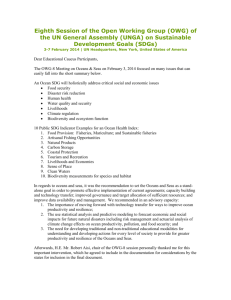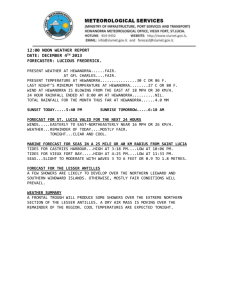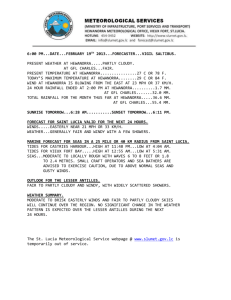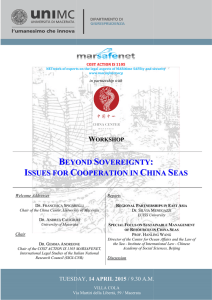the high seas and us - Global Ocean Commission
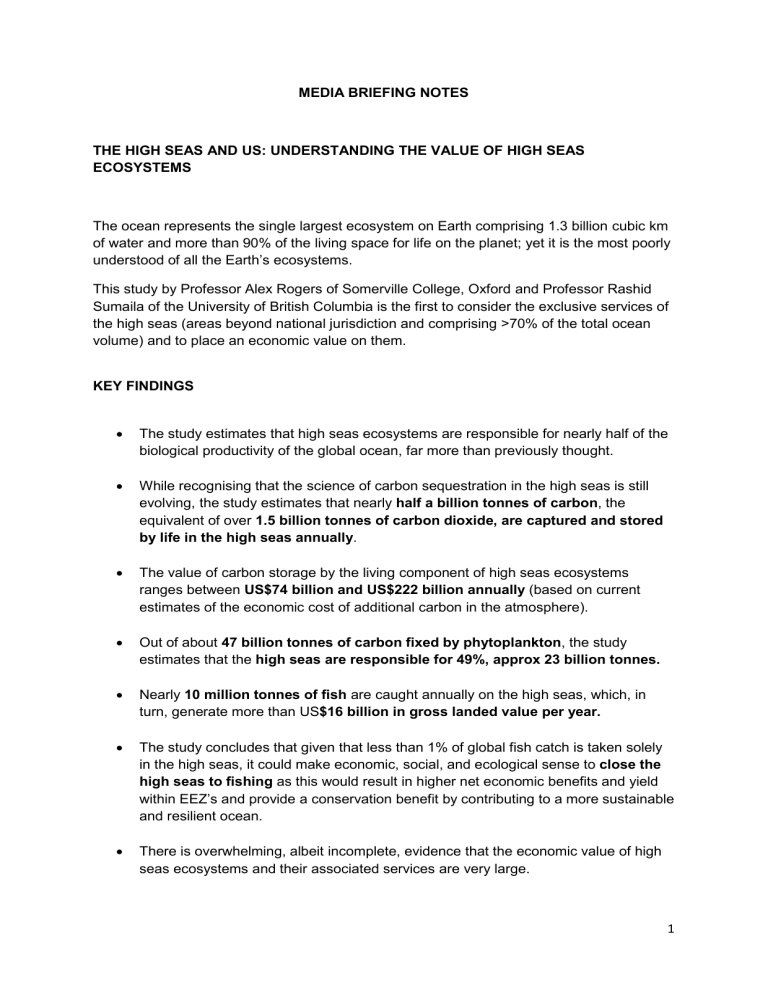
MEDIA BRIEFING NOTES
THE HIGH SEAS AND US: UNDERSTANDING THE VALUE OF HIGH SEAS
ECOSYSTEMS
The ocean represents the single largest ecosystem on Earth comprising 1.3 billion cubic km of water and more than 90% of the living space for life on the planet; yet it is the most poorly understood of all the Earth’s ecosystems.
This study by Professor Alex Rogers of Somerville College, Oxford and Professor Rashid
Sumaila of the University of British Columbia is the first to consider the exclusive services of the high seas (areas beyond national jurisdiction and comprising >70% of the total ocean volume) and to place an economic value on them.
KEY FINDINGS
The study estimates that high seas ecosystems are responsible for nearly half of the biological productivity of the global ocean, far more than previously thought.
While recognising that the science of carbon sequestration in the high seas is still evolving, the study estimates that nearly half a billion tonnes of carbon , the equivalent of over 1.5 billion tonnes of carbon dioxide, are captured and stored by life in the high seas annually .
The value of carbon storage by the living component of high seas ecosystems ranges between US$74 billion and US$222 billion annually (based on current estimates of the economic cost of additional carbon in the atmosphere).
Out of about 47 billion tonnes of carbon fixed by phytoplankton , the study estimates that the high seas are responsible for 49%, approx 23 billion tonnes.
Nearly 10 million tonnes of fish are caught annually on the high seas, which, in turn, generate more than US $16 billion in gross landed value per year.
The study concludes that given that less than 1% of global fish catch is taken solely in the high seas, it could make economic, social, and ecological sense to close the high seas to fishing as this would result in higher net economic benefits and yield within EEZ’s and provide a conservation benefit by contributing to a more sustainable and resilient ocean.
There is overwhelming, albeit incomplete, evidence that the economic value of high seas ecosystems and their associated services are very large.
1
These ecosystems generate both market values and values that are not traded in the market, but still contribute to human economic and social wellbeing.
High seas ecosystems are degraded by past and current usage and threatened by future impacts as industrial uses of the high seas expand.
Better environmental management of the high seas has been hampered by a chronic under-valuation of the economic benefits that will arise from healthier high seas ecosystems.
SUMMARY
We do not understand the value of the high seas in economic, social or cultural terms.
Without this information we cannot make informed decisions about the relative value of allowing overfishing vs the relative value of carbon sequestration, replenishment of coastal fish stocks or oxygen production.
The industrialisation and overuse of the high seas jeopardises the natural wealth of ecosystems there and the services they provide to people.
Mining for minerals and new sources of fossil fuels will likely increase the industrial use of the high seas and will further damage its ecosystems.
The governance of the high seas is fragmented, with different international institutions focusing on specific industrial activities, places, or even different parts of the ecosystem.
There is growing evidence that the ecosystem services provided by the high seas are of high social and economic value. The evidence is also clear that poor management of human activities has eroded the natural wealth and productivity of high seas ecosystems with negative economic and social consequences for all of us.
The Study examines 15* important ecosystem services provided by the high seas. These fall under the following categories:
Provisioning services (seafood; raw materials; genetic resources; medicinal resources; ornamental resources)
Regulating services (air purification; climate regulation; waste control; biological control)
Habitat services (lifecycle maintenance; gene pool protection)
Cultural services (recreation and leisure; aesthetic information; information for culture, art and design; information for cognitive development)
*See Table Appendix A
2
The challenge is that few high seas ecosystem services can be accurately valued due to a lack of scientific information about the use of them, their quantity and nature and even how and where they are produced.
For example the high seas support economically important organisms that swim, migrate or drift well beyond the physical boundaries of the high seas. This makes it difficult to capture the contribution of high seas ecosystems to the services that are produced in the high seas but are enjoyed elsewhere – sometimes thousands of kilometres away.
Therefore, the study assesses the value of these services as far as this is possible and places them in the context of the costs of improved governance and management of human activities in the high seas with a particular focus on improved marine protection.
The study focuses on providing estimates of the economic value of two important, high seas ecosystem services: carbon storage and fisheries.
Carbon Storage
The ocean has captured and stored more than half the carbon dioxide (CO
2
) produced by the burning of fossil fuels and a third of the total produced by humankind. This has reduced the rates of atmospheric CO
2
and can slow changes in global temperature and other consequences associated with climate change.
It occurs through both physical and biological processes. Physical processes include CO
2 dissolving in the ocean and being carried into the deep ocean for hundreds to thousands of years. Biological processes include the ‘fixation’ of carbon by photosynthesis in the surface layers of the ocean by phytoplankton (which then dies and sinks or is consumed, keeping the carbon fixed away from the atmosphere).
The study estimates that of the roughly 47 billion tonnes of carbon fixed by phytoplankton, the high seas are responsible for 49%, i.e. about 23 billion tonnes. (Although coastal regions are more densely productive, the high seas has a very large surface area and thus account for a huge amount of biological productivity in total).
The amount of carbon captured and stored at depth can be estimated from measures of fixed carbon (net primary production) and how it is consumed or decomposed by animals and microorganisms as it sinks.
Using an estimate of the amount of carbon stored below 1,000 metres (0.276 billion tonnes per year), adding carbon exported through other biological mechanisms (nitrification, the carbonate pump and dissolved organic carbon) and accounting for a portion of the continental slope outside EEZs, the study estimates a total figure for biological carbon capture and storage in the high seas of 0.448 billion tonnes of carbon annually.
The estimates of carbon capture and storage in the high seas are preliminary and subject to a great deal of uncertainty because the rate at which organic carbon is consumed as it sinks and the role of animals in actively moving the carbon from the surface into deep water are uncertain.
To account for this uncertainty in calculating the economic value of the service, the authors used the figure of 1.644 billion tonnes CO
2
per year (+/- 50%) as a basis for estimating the
3
economic value of keeping CO
2
out of the atmosphere. Applying a social cost of carbon figure to this, they were then able to derive a total social benefit of carbon capture and storage by the high seas to a value of $148 (ranging between 74 and 222) billion a year.
The estimates do not account for the additional changes which excess CO
2
can bring about in seawater (acidification and temperature increase, both of which are detrimental to ocean health).
Fisheries
The study analyses the economic impacts of high seas fisheries with a focus on the degree of ‘sharing’ and interaction between fish stocks on the high seas and within EEZs. It found that 42% of the global, commercially important fish species analysed are caught both in the high and coastal seas. Less than 1% are caught exclusively on the high seas. The highly migratory and ‘straddling’ stocks, which occur in both the high seas and in EEZs, account for
67% of the total global catch and 72% of total landed value associated with global commercial fisheries.
A total annual average of about 10 million tonnes of fish from highly migratory and straddling stocks were caught in the high seas constituting just over 12% of the global annual average marine fisheries catch of 80 million tonnes. The landed value of this catch is estimated at about US$16 billion annually, 15% of the total global marine landed value of around US$109 billion. Tuna species account for the largest share of value and the second largest share of total catch .
Poorly managed fisheries affect the economic value of the service as well as other aspects of social welfare, including the support of sustainable livelihoods, food security and distributional equity; the impacts may affect the supply of other ecosystem services (e.g. carbon capture and storage).
Focusing on the large pelagic species for which there is good data, the study finds that the
10 leading high seas fishing nations together land 63% of the high seas catch and capture
70% of the landed values. In descending order these are:
Japan
South Korea
Taiwan
Spain
USA
Chile
China
Indonesia
Philippines
France
‘High seas only’ fishing plays a relatively small role in the economic value of global fisheries but a potentially large ecological role in the ocean – supporting the large global fishery that
4
exists within EEZs and some small-scale and subsistence fishing, all the while playing a key role in the global ocean ecosystem.
This paradox suggests that it could make economic, social and ecological sense for the high seas to be completely closed to fishing.
A recent paper (White and Costello, 2014) published in the scientific journal PLOS Biology predicts that closing the high seas completely to fishing would result in higher net economic benefits, relative to the current situation. By protecting the natural capital of fish stocks in the high seas, coastal nations would continue to benefit from the fisheries that depend on the high seas but can be caught in EEZs.
If closing the high seas to commercial fishing results in more fish in the sea, it could also yield a conservation benefit by contributing to a more sustainable and resilient ocean – not only to overfishing but to other threats such as climate change and ocean acidification.
Provisioning Services
Given the physical nature of provisioning services, their supply will strongly depend on the abundance and numbers of species of living organisms within high seas ecosystems and the structure of the communities and food webs they form. For example, if the abundance of phytoplankton declines, organisms higher in the food chain will also decline.
The delivery of provisioning services depends on healthy ecosystems that assure the abundance of economically important species and on ecological functions and community structures that maintain stable food webs.
Regulating Services
It has been widely recognised that the diversity of life, reflected in the ecological characteristics of living organisms of the seabed and water column, plays a fundamental role in the maintenance of regulating services. This is because a diversity of living organisms helps to control essential processes such as sedimentation, nutrient and gas cycling, and the formation of habitat .
Human pressures that disrupt these processes will, in turn, affect the supply of regulating services. For example, phytoplankton contribute to the biological carbon pump. Events and activities that alter the composition of phytoplankton communities are likely to affect the climate regulation service provided by marine ecosystems.
Bacteria, phytoplankton and zooplankton have fundamental roles related to nutrient cycling and the removal of polluting particles from the environment. Whenever the structure of these living communities is altered, the provision of regulating services such as air purification and waste treatment will also likely be altered.
One indication that the service of biological control has already been altered may be found in the bloom of a particular species (e.g. jellyfish or algae). For example, it is thought that overfishing is capable, in some circumstances, of altering ecosystem structures to the point where biological controls cannot re-establish healthy food webs.
5
Habitat Services
The two habitat services likely to be important in the high seas, ‘Lifecycle Maintenance’ and
‘Gene Pool Protection’, are closely related to essential ecological processes.
Changes in any of the critical ecological characteristics can alter the ability of a habitat to support life. Such disruptions include changes in reproductive patterns and the development of juvenile migratory species. For example, declines in the productivity of a habitat used by migratory animals for breeding or for protection of juveniles may force these species to travel longer distances to find suitable alternative locations
Governance, Ecosystem Health and the Services that Benefit Humankind
Human activities drive changes in ecosystem health. Pollution, the transmission of invasive species, and direct habitat destruction (in the case of seafloor extraction) are detrimental to ecological health and ecosystem service values of the high seas. The effects of climate change, especially increasing ocean temperatures, decreasing oxygen and acidification, all have the potential to alter the health and value of ecosystems services.
Many human activities that occur in high seas areas have both positive and negative economic consequences. Some financially profitable activities are arguably independent of ecosystem health, e.g. shipping and mining of deep-seabed mineral resources. Such activities may directly and indirectly damage marine life and ecosystems. Other types of activities depend directly on ecosystem health, yet the poor management of these activities results in damage. For instance, by reducing the productivity and resilience of fish stocks, overfishing has a direct impact on the ability of the high seas to produce seafood. Other impacts of fishing such as bycatch, and the destruction of ecosystems and physical disturbance (e.g. generation of sediment plumes by bottom trawls), can reduce stocks of other types of seafood, and affect lifecycle maintenance, biological control, genetic and medicinal resources, and even climate regulation.
The governance of the high seas is highly fragmented and this fragmentation needs to be taken into account when predicting the potential outcome of better high seas governance.
Indeed, reduced fragmentation may be a proposed reform.
Conclusion
The high seas support at least 15 major categories of ecosystem services that are known to be important to human wellbeing. These ecosystem services have demonstrable economic value. While few of them can be valued using current data, two – carbon capture and storage and commercial fisheries – generate tens of billions of dollars of value to society annually.
High seas marine ecosystem services are thought to generate far less value than could be possible because of uncontrolled and poorly managed human activities that damage them.
Better high seas management could stem the decline in the value of high seas ecosystem services, improve the resilience of high seas ecosystems, and even increase the overall value of these ecosystems and the services they produce.
6
There is overwhelming, albeit incomplete, evidence that the economic value of high seas ecosystems and their associated services is vast.
ENDS
The full study and an Executive Summary are available on request.
For further information please contact:
Nick Steel, nick@communicationsinc.co.uk
, tel: (+44)7830185072
7


